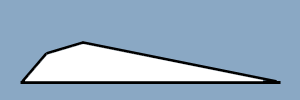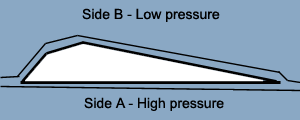The Physics of Sailing
A sailing boat is powered through the water by the wind. This happens, because of the physics of aerodynamics.
A sail is in the shape of an aerofoil (the same as an aeroplane). An aerofoil in a sail is the same as an aerofoil in a plane, which is of course the wings.

Sorry about the image. I am no graphics designer!
Here is an aerofoil.
The physics of plane wings is exactly the same as in sailing. In sailing boats, the wind is hitting the sail, creating the thrust.
The wind goes around the sail.
However, because the sail is curved, the wind on one side of the sail (lets say side "A") has to travel further, but on the other side (lets say "B") it has to travel less far.
This means that on side "A", the wind will have to travel faster then side "B".
Because of this, there will be a lower pressure on side "A" than side "B".
High pressure naturally moves to a lower pressure area. This creates lift.

This lift drives the sail in the opposite direction to the wind. However through the use of a keel or centreboard, the lift energy is converted into forward kinetic energy.
The centreboard or keel, reduces the heeling of the boat (ie: when it tips to the side). The centreboard or keel grips the water and the path of least resistance is forwards (or backwards).
So there you have it! The physics of sailing. However just knowing about lift and forces won't help you sail well. In fact it probably won't help you at all. But at least you will be one step further to sailing master!
Return from Physics of Sailing to Sailboat Sails
Return from Physics of Sailing to Started Sailing

